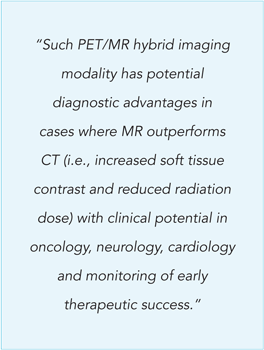|
|
||||
|
April 2015 • Vol. 4, Issue 2 |
||||
| A Message from the SMRT Home Study Educational Seminars Publications Committee | ||||
 |
Anne Marie Sawyer, B.S., R.T.(R)(MR), FSMRT Home Study Program Lucas Center for Imaging Stanford University, Stanford, California, USA T: +1 650 725 9697 E: amsawyer@stanford.edu |
 |
Vanessa Orchard, DCR(D), PGDip.(Nuc Med),
M.Sc.(MRI) Lead Radiographer Cardiac Imaging Centre Golden Jubilee National Hospital Dunbartonshire, Glasgow, Scotland, UK T: +0141 951 5187 E: vanessa.orchard@gjnh.scot.nhs.uk |
|
|
MR-PET
(Positron Emission Tomography) |
||||
|
We are pleased to present the SMRT Home Study Educational Seminar, Volume 18, Number 2: MR-PET (Positron Emission Tomography). This is the 68th accredited Home Study developed by the SMRT, exclusively for SMRT members. The accreditation is conducted by the SMRT acting as a RCEEM (Recognized Continuing Education Evaluation Mechanism) for the ARRT. Category A credits are assigned to each home study, which can be used to maintain one’s ARRT advanced registry. SMRT Home Studies Educational Seminars are also approved for AIR (Australian Institute of Radiography), NZIMRT (New Zealand Institute of Radiation Technology) and CPD Now (The College of Radiographers, United Kingdom) continuing professional development (CPD) activities.
The authors of the second article continue to expand on the technology of MR-PET but with more specific information regarding the adaptation and optimization of imaging software given the challenges of hardware modifications required to merge these two complex imaging systems. They support this endeavor by saying “As the newest hybrid imaging technology, simultaneous PET/MR combines these exciting areas of growth for radiology and nuclear medicine and further bridges the divide between anatomic and molecular imaging. PET/ MR can noninvasively provide molecular, functional, and anatomic information in a single imaging session using FDG and other PET tracers in conjunction with state-of-the-art MRI.” In the third and final article that discusses the initial experience at a clinical cancer center with MR/PET, the authors begin by reminding us: “Staging, re-staging and therapy monitoring are important steps in the management of oncologic patients. All of these imaging management categories consist of a determination of the local tumor extent, detection of adenopathy, and secondary spread to their organs. MR/PET leverages the inherent strengths of both technologies and thereby opens new horizons in functional and molecular imaging.” A special thank you to Julia Lowe, B.S., R.T.(R)(MR) from Columbus, Indiana, USA, for acting as the Expert Reviewer. Thanks also to Heidi Berns, M.S., R.T.(R)(MR), FSMRT, Chair of the SMRT RCEEM Ad-hoc committee from Coralville, Iowa, USA, and all those who participate on this committee by reviewing the Home Studies Educational Seminars for accreditation. Finally, many thanks to Kerry Crockett, Associate Executive Director, ISMRM/SMRT, Mary Keydash, Publications Director, Linda O-Brown, SMRT Coordinator, Sally Moran, Director of Electronic Communications and the entire staff in the Berkeley, California, USA, office of the ISMRM and SMRT, for their insight and long hours spent supporting these educational symposia. |
||||
|
Click here to continue to the SMRT Online Education website. |
||||
|
E-Signals is a publication by the International Society for Magnetic Resonance in Medicine for the benefit of the SMRT membership and those individuals and organizations that support the educational programs and professional advancement of the SMRT and its members. This publication is the compilation of the leadership of the SMRT and the contributions of the staff in the ISMRM Central Office. |
||||

 Three peer-reviewed articles have been chosen
for this Home Study issue. As introduced in the first article by the
authors, “Initiated by the success story of hybrid imaging by
combining positron emission tomography (PET) and computed tomography
(CT) in PET/CT, researchers have pursued the technically challenging
but diagnostically attractive idea of integrating PET and MR imaging
in one single system. Such PET/ MR hybrid imaging modality has
potential diagnostic advantages in cases where MR outperforms CT
(i.e., increased soft tissue contrast and reduced radiation dose)
with clinical potential in oncology, neurology, cardiology and
monitoring of early therapeutic success.” What follows is an
intriguing and detailed description of this recently introduced
hybrid-imaging modality.
Three peer-reviewed articles have been chosen
for this Home Study issue. As introduced in the first article by the
authors, “Initiated by the success story of hybrid imaging by
combining positron emission tomography (PET) and computed tomography
(CT) in PET/CT, researchers have pursued the technically challenging
but diagnostically attractive idea of integrating PET and MR imaging
in one single system. Such PET/ MR hybrid imaging modality has
potential diagnostic advantages in cases where MR outperforms CT
(i.e., increased soft tissue contrast and reduced radiation dose)
with clinical potential in oncology, neurology, cardiology and
monitoring of early therapeutic success.” What follows is an
intriguing and detailed description of this recently introduced
hybrid-imaging modality.